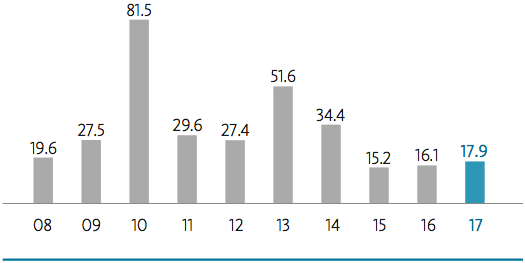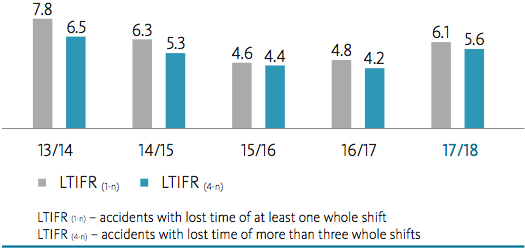Environmental protection and occupational health
Environmental protection in the Group
We take responsibility for protecting our environment and our climate. Our production facilities therefore use modern and energy-efficient plant technology that also complies with very high environmental standards. In this way, we conserve natural resources and maintain a clean environment for future generations. We have set targets in environmental protection, defined corresponding KPIs, and established measures to achieve the targets across the Group. The effectiveness of these targets and measures is reviewed continuously.
Capital expenditure for environmental protection in copper production
in € million

The continuous improvement of water pollution control, soil conservation, climate protection, and emission prevention are all key to achieving sustainable environmental protection. For this reason, Aurubis has invested more than € 560 million in environmental protection measures in primary and secondary copper production since 2000.
Occupational health in the Group
Corporate Occupational Health and Safety is responsible for ensuring that the technical, organizational, and personal conditions in place in the company are designed to prevent work-related accidents and illnesses.
The acronym LTIFR (1-n) indicates the accident rate in the company. It stands for “Lost Time Injury Frequency Rate” and refers to the number of work-related accidents with at least one lost shift per one million hours worked.
After having seen its accident rate fall continuously and substantially over the past several years, Aurubis experienced an accident rate increase in the reporting year, with an LTIFR (1-n) of 6.1 for fiscal year 2017/18 compared with 4.8 in the previous year. In absolute terms, this equated to 60 accidents in the reporting year compared with 47 in the previous year.
We have been setting short-term and medium-term occupational safety targets since 2010 and are working towards our long-term “Vision Zero,” that is, a completely accident-free work environment. Our medium-term goal is to achieve an LTIFR (1-n) of ≤ 1.0.
Accident frequency
LTIFR = Lost Time Injury Frequency Rate

